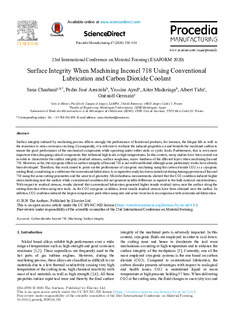Izenburua
Surface Integrity When Machining Inconel 718 Using Conventional Lubrication and Carbon Dioxide CoolantBeste instituzio
Arts et Metiers Institute of TechnologyUniversité de Lorraine
Bertsioa
Bertsio argitaratua
Eskubideak
© 2020 The AuthorsSarbidea
Sarbide irekiaArgitaratzailearen bertsioa
https://doi.org/10.1016/j.promfg.2020.04.150Non argitaratua
Procedia Manufacturing Vol. Pp. 530-534, 2020Lehenengo orria
530Azken orria
534Argitaratzailea
Elsevier Ltd.Gako-hitzak
Carbon dioxideInconel 718
Machining
Surface integrity
Laburpena
Surface integrity induced by machining process affects strongly the performance of functional products, for instance, the fatigue life as well as the resistance to stress corrosion cracking. Consequen ... [+]
Surface integrity induced by machining process affects strongly the performance of functional products, for instance, the fatigue life as well as the resistance to stress corrosion cracking. Consequently, it is relevant to evaluate the induced properties on and beneath the machined surface to ensure the good performance of the mechanical components while operating under either static or cyclic loads. Furthermore, this is even more important when designing critical components that withstand high loads at high temperatures. In this context, many studies have been carried out in order to characterize the surface integrity (residual stresses, surface roughness, micro-hardness of the affected layer) when machining Inconel 718. However, so far, the cryogenic effect on surface integrity of Inconel 718 is not well established although some preliminary works have already been developed. Therefore, this work aimed to point out the performance of cryogenic machining using the carbon dioxide CO2 as a cryogenic cutting fluid, considering as a reference the conventional lubrication. A comparative study has been carried out during turning operations of Inconel 718 using the same cutting parameters and the same tool geometry. Microhardness measurements showed that the CO2 condition induced higher strain hardening near the surface while conventional condition did not generate notable difference compared to the bulk material microhardness. With respect to residual stresses, results showed that conventional lubrication generated higher tensile residual stress near the surface along the cutting direction when using new tools. As for CO2 cryogenic condition, lower tensile residual stresses have been obtained near the surface. In addition, CO2 condition induced the largest compressive peak when using new and semi−worn tools in comparison with conventional lubrication. [-]
Sponsorship
Gobierno VascoProjectu ID
GV/Elkartek 2019/KK-2019-00004/CAPV/Procesos de alto valor basados en el conocimiento y los datos/PROCODABildumak
Item honek honako baimen-fitxategi hauek dauzka asoziatuta:






















